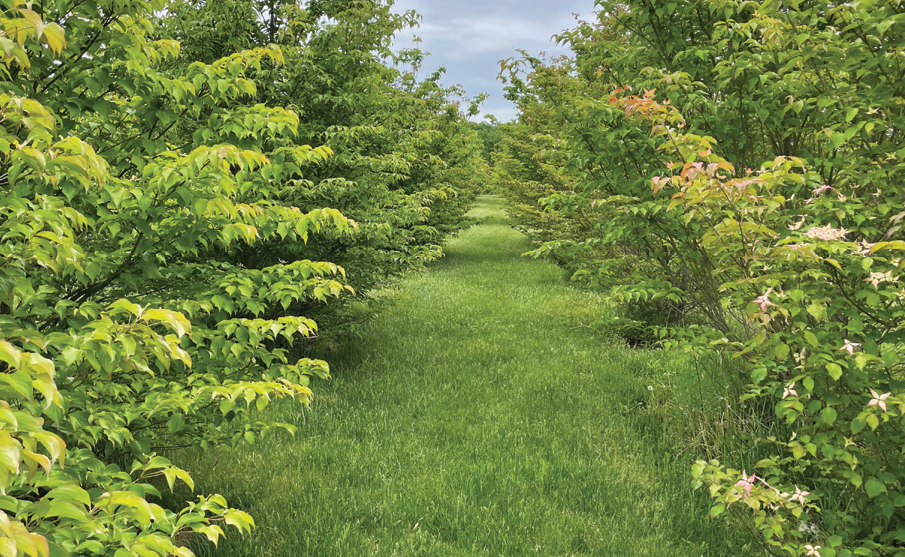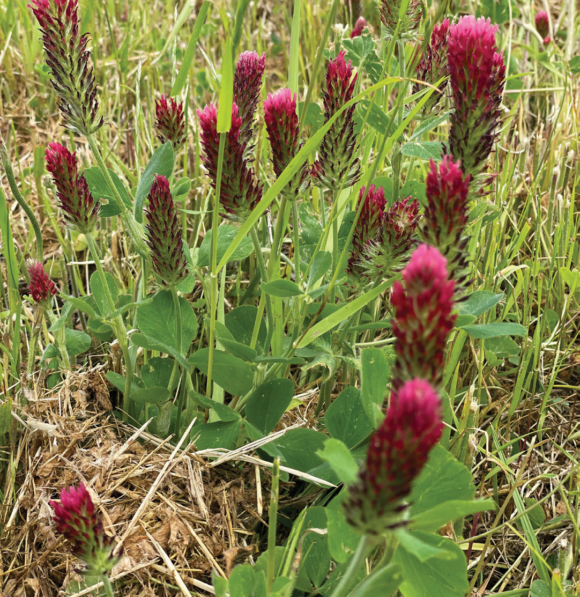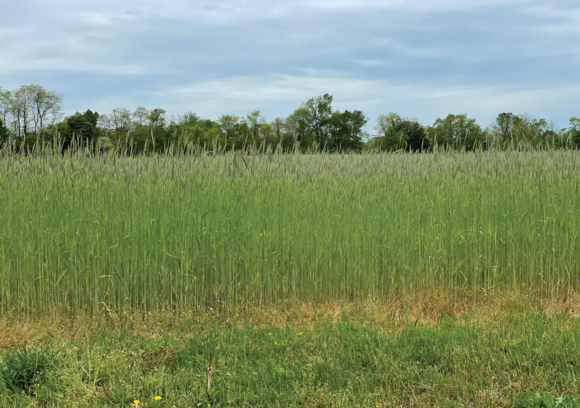
Planting turfgrass between rows helps conserve soil in production areas.
Photo: William Errickson.
By William Errickson, agricultural agent, Rutgers Cooperative Extension, Monmouth County
As nursery growers, we ask a lot of our soils. They work for us 365 days a year and never take a break. Since crop growth and plant health are literally rooted in the soil, we need to consider what qualities make a soil ideal for plant growth and how we can help our soil reach its full potential. For nursery crops, the ideal soil will be loose and friable to support strong root growth yet should be well-structured to hold together when digging out root balls. It will also have high levels of biological activity and nutrient holding capacity while resisting pathogens and limiting weed growth. This may seem like a tall order but focusing on practices that support soil health can have additive effects that can lead to real cost-saving benefits in the field.

On sloped lands, contour plantings can help minimize erosion, especially in combination with field edge buffer strips. Photo: William Errickson.
“Soil health, also referred to as soil quality, is defined as the continued capacity of soil to function as a vital living ecosystem that sustains plants, animals & humans,” according to the USDA Natural Resource Conservation Service (NRCS).
We can think of soil health like a bank account. It requires some smart initial investments, but the benefits will pay dividends over the long term if we stay the course. The sooner you can start investing in soil health, the better off your plants will be. Improving soil health is a process that will require attention each year to build upon the initial investments, but employing a few simple, cost-effective strategies can go a long way toward enhancing this key resource.
While soil science is a vast and complex topic, improving soil health can be distilled down to two key strategies: 1. Minimizing soil disturbance. 2. Adding and maintaining high levels of organic matter.
Minimizing soil disturbance
Soil disturbance in a field nursery occurs through general field operations. Strategies to minimize soil losses and soil compaction are the first step to protect the valuable soil that is currently in your field. Soil losses from erosion can be caused by wind or water. Bare soil is more susceptible to erosion than soil that is covered with plants or mulch, and sloped land is also more vulnerable. On sloped lands, contour plantings can help to minimize erosion, especially in combination with field edge buffer strips. Vegetative buffers can slow runoff and trap sediment, which can significantly reduce soil losses.

Crimson clover is an effective cover crop because it releases nitrogen into the soil as the clover breaks down. Photo: William Errickson.
Planting turfgrass or other cover crops between rows will further help to conserve soil in production areas, while reducing the number of times that heavy equipment has to make passes on the field can help to reduce soil compaction. The impacts of soil compaction are also worse when the soil is wet, so putting equipment on the field when it is wet should be avoided entirely. If soil compaction becomes a problem, restricting root growth or water movement through the soil, corrective measures can be taken, including using a subsoiler to break up the compaction layer, combined with cover crops or other organic matter additions to help repair the damage. However, frequent tillage will deplete organic matter, disturb soil organisms, and reduce porosity, leading back to a cycle of compaction issues. Minimizing tillage and using equipment such as a spader instead of a rototiller when tillage is required can help to reduce these impacts.

Cereal rye can be planted as a cover crop later in the season and survives the winter to help stabilize the soil and absorb excess nutrients. Photo: William Errickson.
Soil Organic Matter (SOM)
Perhaps the most essential component of soil health is soil organic matter (SOM), which refers to the living, and previously living, carbon-based components of the soil. This includes living organisms (i.e. plant roots, bacteria, and fungi), fresh residues (i.e. fresh leaves or grass clippings), and other components in various stages of decomposition. Adequate SOM enhances biological activity, improves soil structure, increases water holding capacity, sequesters carbon, and improves cation exchange capacity (CEC). Cation exchange capacity refers to the ability of SOM or other soil particles to hold onto cations (such as Ca2+, Mg2+, and K+) in a way that makes them available to plants and reduces the potential for leaching of these nutrients.
This article first appeared in Nursery Management.

